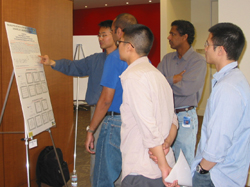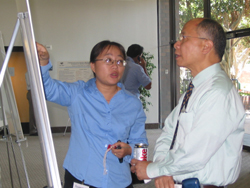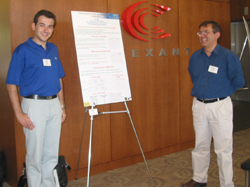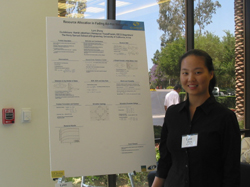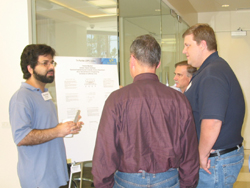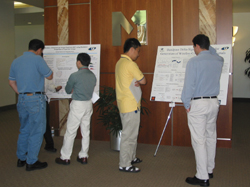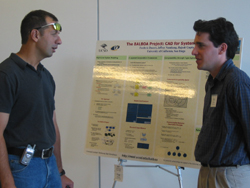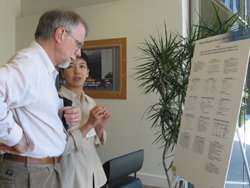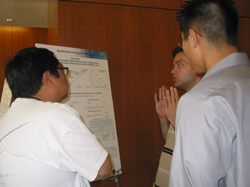Finding a Receptive Audience, Graduate Students Take Their Research to Industry
|
5.26.04 - It wasn’t difficult for employees of Conexant Systems, Inc. and Mindspeed Technologies, Inc. to attend the recent Calit² sponsored student poster presentations. All they had to do was take the elevator to their building lobbies to participate.
The poster session held on-site at the Newport Beach offices was organized by UCI’s Center for Pervasive Communications and Computing (CPCC), a collaborative research unit with Calit². A total of 30 graduate students, 15 from UC Irvine and 15 from UC San Diego, displayed their research.
“It’s not easy for our technical staff to get out of their offices and attend off-site research presentations,” said Debbie Mountford, director of staffing and university relations at Conexant. “We decided it was a great idea to bring the research to them and based on the reaction it appears to be the way to go.”
|
The CEO of Mindspeed, Raouf Halim, remarked to Albert Yee, UCI Division Director, on how impressed he was with the work presented. “I made several job offers on the spot”, said Halim to Yee.
Dwight Decker, Chairman of Conexant, praised the work presented as being highly relevant to industry’s needs, and “real.”
All Conexant, Mindspeed and Skyworks employees and technical teams located in Newport Beach, Irvine and San Diego received invitations to the poster sessions. The idea of bringing the students into the workplace was something that Ender Ayanoglu, CPCC director, had been considering for some time.
|
“It’s a win-win situation. We get to engage our best graduate students with our industry partners and see what develops,” said Ayanoglu.
After a brief welcome and light lunch provided by the companies, the students spread out between the lobbies of the two buildings, standing by their posters, willing and eager to explain their research.
Among the presenters was second year UCI graduate student Lynn Zheng who will be receiving her Master’s degree this spring in Electrical Engineering and Computer Science in The Henry Samueli School of Engineering. Zheng has been studying resource allocation in fading ad-hoc networks under the advisement of Professor Hamid Jafarkhani and will be doing a summer internship at another Calit² industry partner, Broadcom.
|
“I was nervous about how it would go, what level of interest and questions I would get from those looking at my poster, but it has been very rewarding,” said Zheng. “I’ve talked with all levels of expertise from the novice to the experienced engineer. It was very exciting to see the level of interest and I think I actually learned a lot while describing my work.”
A few posters down the Conexant lobby stood Peyman Meshkat, a post-doctoral fellow with CPCC. Meshkat, who received his Ph.D. from UCLA in 2001, was presenting his work on tri-partite LDPC codes. In a wireless system, interference, reflection or other factors can cause information bits transmitted from source to recipient to be missed or misinterpreted. Error-checking algorithms, such as including check bits or analyzing the bits in a packet in relation to each other, can reduce the problem, but the error-checking systems themselves require additional bandwidth and power.
|
“Decoding of LDPC codes have so far relied on message passing between two levels,” explained Meshkat. “I propose a three-level process that significantly improves error detection performance of the code.”
Meshkat’s research was well-received drawing many industry representatives at any given time who were visibly engaged in finding out more. “I spend a lot of time pursuing my research but I don’t get as much time to talk about my research,” added Meshkat. “During this interaction not only was I able to describe what I have been doing, but I think I have also learned a few new ways of looking at my research and even some new ideas.”
A random sampling of other presentations includes:
Ahmad Yazdi, “IC Design for Ultra-Wideband Wireless Radio”
Ultra-wideband transmission (UWB) conveys information by using an extremely wide range of frequencies, in extremely short pulses. Such systems prove to be useful for transmitting large amounts of information with high security, and for transmission through many different materials, but only over short distances. UWB is used, for example, for short-range control of many devices in a network, or for “see through walls” radar systems. Yazdi’s work concerns the challenges of developing UWB radio circuits on integrated microprocessor boards.
Nhi Pham, “Minimized Dual-Band Coupled Line Meander Antenna for System-in-a-Package Applications”
As wireless devices get smaller, there is a premium on reducing the size of the antenna as well. The design of effective antennas that can be printed on a circuit board is therefore an increasingly important topic. Meander antennas, in which the entire length of the antenna is accommodated in a back-and-forth pattern on the board, are often used for this purpose. Pham’s work establishes that the addition of a small additional strip alongside the meander pattern can give the antenna a second characteristic wavelength.
Peifang Zhang, “Power Control in CDMA Wireless Network by Pricing”
In a cellular network each cell’s power consumption is determined by the number of local users using the cell, the call loads transferred from adjacent cells, and interference levels, among other factors. Users’ satisfaction with the service (the users’ “utility”, in economists’ terminology) is curtailed if the cell gets overloaded by any of those factors. Currently cells accept calls on a first-come first-served basis, and user pricing is based only on general expectations about load levels. Zhang developed a model that would optimize the users’ collective utility by including inter-cell transfer policies based on power demands and user pricing based on willingness to pay.
Raja Jurdak, “Battery Lifetime of Underwater Sensor Networks”
Underwater sensors, communicating by acoustic signals, are important for such applications as seismic sensing, pollution monitoring, climate prediction, and defense. Usually such sensors are combined into a network served by a radio buoy at the surface. Many applicable sensors exist, even ones that can withstand the marine environment, but the critical limiting factor at present is battery life. Jurdak’s work examines how the battery life is affected by the geographic distance between sensors, the topology of the network connections (e.g., tree vs. chain), the acoustic frequencies used, and how often updates are performed. His work suggests that tier dependent distance assignments achieve the best power behavior and network coverage, although precise distance placements are very difficult in the underwater environment; tier dependent frequency assignments are more suitable for self-organizing networks.
|
|
||||||
|
|

